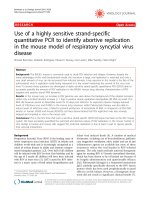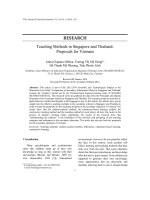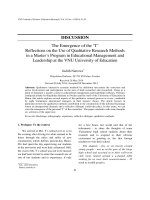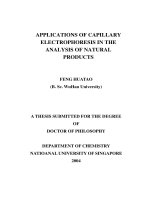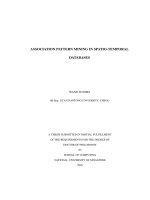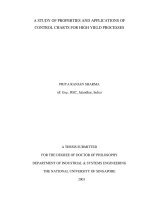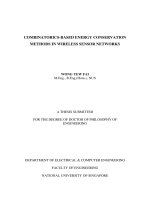Applications of spatio temporal analytical methods in surveillance of ross river virus disease
Bạn đang xem bản rút gọn của tài liệu. Xem và tải ngay bản đầy đủ của tài liệu tại đây (579.78 KB, 138 trang )
APPLICATIONS OF SPATIO-TEMPORAL
ANALYTICAL METHODS IN SURVEILLANCE OF
ROSS RIVER VIRUS DISEASE
BY
WENBIAO HU BMed
A thesis submitted for the Degree of Doctor of Philosophy in the Centre
for Health Research, Queensland University of Technology
MAY 2005
For my wife, Xiaodong and our son Junqian
II
KEYWORDS
Classification and regression trees, cluster analysis, generalised linear model,
geographic information system, interpolation, polynomial distributed lag model,
principal components analysis, Ross River virus disease, seasonal auto-regressive
integrated moving average, socio-ecological factors, time series analysis
III
SUMMARY
The incidence of many arboviral diseases is largely associated with social and
environmental conditions. Ross River virus (RRV) is the most prevalent arboviral
disease in Australia. It has long been recognised that the transmission pattern of RRV
is sensitive to socio-ecological factors including climate variation, population
movement, mosquito-density and vegetation types. This study aimed to assess the
relationships between socio-environmental variability and the transmission of RRV
using spatio-temporal analytic methods.
Computerised data files of daily RRV disease cases and daily climatic variables in
Brisbane, Queensland during 1985-2001 were obtained from the Queensland
Department of Health and the Australian Bureau of Meteorology, respectively.
Available information on other socio-ecological factors was also collected from
relevant government agencies as follows: 1) socio-demographic data from the
Australia Bureau of Statistics; 2) information on vegetation (littoral wetlands,
ephemeral wetlands, open freshwater, riparian vegetation, melaleuca open forests, wet
eucalypt, open forests and other bushland) from Brisbane City Council; 3) tidal
activities from the Queensland Department of Transport; and 4) mosquito-density
from Brisbane City Council.
Principal components analysis (PCA) was used as an exploratory technique for
discovering spatial and temporal pattern of RRV distribution. The PCA results show
that the first principal component accounted for approximately 57% of the
information, which contained the four seasonal rates and loaded highest and positively
for autumn. K-means cluster analysis indicates that the seasonality of RRV is
IV
characterised by three groups with high, medium and low incidence of disease, and it
suggests that there are at least three different disease ecologies. The variation in
spatio-temporal patterns of RRV indicates a complex ecology that is unlikely to be
explained by a single dominant transmission route across these three groupings.
Therefore, there is need to explore socio-economic and environmental determinants of
RRV disease at the statistical local area (SLA) level.
Spatial distribution analysis and multiple negative binomial regression models were
employed to identify the socio-economic and environmental determinants of RRV
disease at both the city and local (ie, SLA) levels. The results show that RRV activity
was primarily concentrated in the northeast, northwest and southeast areas in
Brisbane. The negative binomial regression models reveal that RRV incidence for the
whole of the Brisbane area was significantly associated with Southern Oscillation
Index (SOI) at a lag of 3 months (Relative Risk (RR): 1.12; 95% confidence interval
(CI): 1.06 - 1.17), the proportion of people with lower levels of education (RR: 1.02;
95% CI: 1.01 - 1.03), the proportion of labour workers (RR: 0.97; 95% CI: 0.95 –
1.00) and vegetation density (RR: 1.02; 95% CI: 1.00 – 1.04). However, RRV
incidence for high risk areas (ie, SLAs with higher incidence of RRV) was
significantly associated with mosquito density (RR: 1.01; 95% CI: 1.00 - 1.01), SOI at
a lag of 3 months (RR: 1.48; 95% CI: 1.23 - 1.78), human population density (RR:
3.77; 95% CI: 1.35 - 10.51), the proportion of indigenous population (RR: 0.56; 95%
CI: 0.37 - 0.87) and the proportion of overseas visitors (RR: 0.57; 95% CI: 0.35 –
0.92). It is acknowledged that some of these risk factors, while statistically significant,
are small in magnitude. However, given the high incidence of RRV, they may still be
important in practice. The results of this study suggest that the spatial pattern of RRV
V
disease in Brisbane is determined by a combination of ecological, socio-economic and
environmental factors.
The possibility of developing an epidemic forecasting system for RRV disease was
explored using the multivariate Seasonal Auto-regressive Integrated Moving Average
(SARIMA) technique. The results of this study suggest that climatic variability,
particularly precipitation, may have played a significant role in the transmission of
RRV disease in Brisbane. This finding cannot entirely be explained by confounding
factors such as other socio-ecological conditions because they have been unlikely to
change dramatically on a monthly time scale in this city over the past two decades.
SARIMA models show that monthly precipitation at a lag 2 months (β=0.004,
p=0.031) was statistically significantly associated with RRV disease. It suggests that
that there may be 50 more cases a year for an increase of 100 mm precipitation on
average in Brisbane. The predictive values in the model were generally consistent
with actual values (root-mean-square error (RMSE): 1.96). Therefore, this model may
have applications as a decision support tool in disease control and risk-management
planning programs in Brisbane.
The Polynomial distributed lag (PDL) time series regression models were performed
to examine the associations between rainfall, mosquito density and the occurrence of
RRV after adjusting for season and auto-correlation. The PDL model was used
because rainfall and mosquito density can affect not merely RRV occurring in the
same month, but in several subsequent months. The rationale for the use of the PDL
technique is that it increases the precision of the estimates. We developed an epidemic
forecasting model to predict incidence of RRV disease. The results show that 95%
and 85% of the variation in the RRV disease was accounted for by the mosquito
VI
density and rainfall, respectively. The predictive values in the model were generally
consistent with actual values (RMSE: 1.25). The model diagnosis reveals that the
residuals were randomly distributed with no significant auto-correlation. The results
of this study suggest that PDL models may be better than SARIMA models (R-square
increased and RMSE decreased). The findings of this study may facilitate the
development of early warning systems for the control and prevention of this widespread disease.
Further analyses were conducted using classification trees to identify major mosquito
species of Ross River virus (RRV) transmission and explore the threshold of mosquito
density for RRV disease in Brisbane, Australia. The results show that Ochlerotatus
vigilax (RR: 1.028; 95% CI: 1.001 – 1.057) and Culex annulirostris (RR: 1.013, 95%
CI: 1.003 – 1.023) were significantly associated with RRV disease cycles at a lag of 1
month. The presence of RRV was associated with average monthly mosquito density
of 72 Ochlerotatus vigilax and 52 Culex annulirostris per light trap. These results may
also have applications as a decision support tool in disease control and riskmanagement planning programs.
As RRV has significant impact on population health, industry, and tourism, it is
important to develop an epidemic forecast system for this disease. The results of this
study show the disease surveillance data can be integrated with social, biological and
environmental databases. These data can provide additional input into the
development of epidemic forecasting models. These attempts may have significant
implications in environmental health decision-making and practices, and may help
health authorities determine public health priorities more wisely and use resources
more effectively and efficiently.
VII
TABLE OF CONTENTS
KEYWORDS...............................................................................................................III
SUMMARY.................................................................................................................IV
TABLE OF CONTENTS...............................................................................................1
LIST OF TABLES .........................................................................................................5
LIST OF FIGURES .......................................................................................................7
DEFINITION OF TERMS ..........................................................................................10
ABBREVIATIONS .....................................................................................................12
STATEMENT OF ORIGIANL AUTHORSHIP .........................................................13
ACKNOWLEDGEMENTS.........................................................................................14
PUBLICATIONS BY THE CANDIDATE (2001 - 2004) ..........................................16
CHAPTER 1: INTRODUCTION AND BACKGROUND.....................................20
1.1 INTRODUCTION .................................................................................................20
1.2 AIMS AND HYPOTHESES .................................................................................24
1.3 SIGNIFICANCE OF THE THESIS ......................................................................25
1.4 CONTENTS AND STRUCTURE OF THE THESIS ...........................................26
CHAPTER 2: APPLICATIONS OF GIS AND SPATIAL ANALYSIS IN
MOSQUITO-BORNE DISEASE RESEARCH: A REVIEW OF RELATED
LITERATURE ...........................................................................................................29
2.1 SYSTEMATIC REVIEW ......................................................................................29
2.2 CRITICAL APPRAISAL OF KEY SPATIO-TEMPORAL ANALYTIC
METHODS ..................................................................................................................40
1
2.3 APPLICATIONS OF GIS AND SPATIO-TEMPORAL ANALYTIC METHODS
IN RRV RESEARCH ..................................................................................................51
2.4 KNOWLEDGE GAPS IN THIS AREA................................................................56
CHAPTER 3: STUDY DESIGN AND METHOD..................................................58
3.1 STUDY SITE AND STUDY POPULATION.......................................................58
3.2 STUDY DESIGN...................................................................................................61
3.3 DATA COLLECTION AND MANAGEMENT...................................................61
3.4 DATA LINKAGES ...............................................................................................63
3.5 DATA ANALYSIS................................................................................................63
3.6 THE LIMITATIONS OF THE STUDY................................................................69
CHAPTER 4: SPATIAL AND TEMPORAL PATTERNS OF ROSS RIVER
VIRUS IN BRISBANE, AUSTRALIA.....................................................................72
ABSTRACT.................................................................................................................73
4.1 INTRODUCTION .................................................................................................74
4.2 MATERIAL AND METHODS .............................................................................76
4.3 RESULTS ..............................................................................................................78
4.4 DISCUSSION ........................................................................................................84
REFERENCES ............................................................................................................89
CHAPTER 5: SPATIAL ANALYSIS OF SOCIAL AND ENVIRONMENTAL
FACTORS ASSOCIATED WITH ROSS RIVER VIRUS IN BRISBANE,
AUSTRALIA ..............................................................................................................93
ABSTRACT.................................................................................................................94
5.1 INTRODUCTION .................................................................................................95
2
5.2 MATERIALS AND METHODS...........................................................................96
5.3 RESULTS ..............................................................................................................99
5.4 DISCUSSION ......................................................................................................107
REFERENCES ..........................................................................................................114
CHAPTER 6: DEVELOPMENT OF A PREDICTIVE MODEL FOR ROSS
RIVER VIRUS DISEASE IN BRISBANE, AUSTRALIA...................................119
ABSTRACT...............................................................................................................120
6.1 INTRODUCTION ...............................................................................................121
6.2 MATERIALS AND METHODS.........................................................................123
6.3 RESULTS ............................................................................................................128
6.4 DISCUSSION ......................................................................................................141
ACKNOWLEDGEMENTS.......................................................................................146
REFERENCES ..........................................................................................................147
CHAPTER
7:
RAINFALL,
MOSQUITO
DENSITY
AND
THE
TRANSMISSION OF ROSS RIVER VIRUS: AN EPIDEMIC FORECASTING
MODEL ....................................................................................................................153
ABSTRACT...............................................................................................................154
7.1 INTRODUCTION ...............................................................................................155
7.2 METHODS ..........................................................................................................157
7.3 RESULTS ............................................................................................................159
7.4 DISCUSSION ......................................................................................................167
ACKNOWLEDGEMENTS.......................................................................................170
APPENDIX................................................................................................................171
3
REFERENCES ..........................................................................................................172
CHAPTER 8: MOSQUITO SPECIES AND THE TRANSMISSION OF ROSS
RIVER VIRUS IN BRISBANE, AUSTRALIA.....................................................176
ABSTRACT...............................................................................................................177
8.1 INTRODUCTION ...............................................................................................178
8.2 MATERIALS AND METHODS.........................................................................179
8.3 RESULTS ............................................................................................................181
8.4. DISCUSSION .....................................................................................................188
ACKNOWLEDGEMENTS.......................................................................................190
REFERENCES ..........................................................................................................191
CHAPTER 9: GENERAL DISCUSSION .............................................................194
9.1 INTRODUCTION ...............................................................................................194
9.2 SUBSTANTIVE DISCUSSION..........................................................................194
9.3 THE IMPLICATIONS OF THE STUDY ...........................................................201
9.4 THE STRENGTHS AND LIMITATIONS OF THE STUDY ............................203
9.5 RECOMMENDATIONS.....................................................................................205
APPENDIX................................................................................................................211
DATA COLLECTION ..............................................................................................211
REFERENCES ..........................................................................................................225
4
LIST OF TABLES
TABLE 2. 1 THE CODING CATEGORIES FOR THE LITERATURE REVIEW .....................32
TABLE 2. 2 ARTICLE NUMBERS BY JOURNAL BASED ON GENERAL HEALTH DOMAIN
(FIRST 50 JOURNALS) ..........................................................................................34
TABLE 2. 3 ARTICLE NUMBERS BY JOURNAL BASED ON MBD...................................35
TABLE 2. 4 CHARACTERISTICS OF 58 MBD PAPERS ..................................................38
TABLE 2. 5 STATISTICAL TECHNIQUES AND COMPUTER SOFTWARE FOR SPATIAL
ANALYSIS*............................................................................................................43
TABLE 4. 1 PRINCIPAL COMPONENT EIGENVALUES AND LOADING FOR EACH SEASON
VARIABLES ...........................................................................................................83
TABLE 4. 2 STATISTICAL CRITERIA FOR THE NUMBERS OF CLUSTERS ......................83
TABLE 4. 3 ANALYSIS OF VARIANCE IN CLUSTER ANALYSIS ......................................84
TABLE 5. 1 SPEARMAN CORRELATION COEFFICIENTS BETWEEN MONTHLY
INCIDENCE OF RRV AND SOCIAL AND ENVIRONMENTAL VARIABLES IN
BRISBANE*.........................................................................................................102
TABLE 5. 2 ADJUSTED RELATIVE RISKS FOR THE TRANSMISSION OF RRV IN
BRISBANE, AUSTRALIA*....................................................................................107
TABLE 6. 1 CHARACTERISTICS OF EXPLANATORY VARIABLES...............................129
TABLE 6. 2 REGRESSION COEFFICIENTS OF SARIMA ON THE MONTHLY INCIDENCE
OF RRV DISEASE IN BRISBANE, AUSTRALIA, 1985 – 2000 ...............................137
TABLE 7. 1 SPEARMAN CORRELATION COEFFICIENTS BETWEEN MONTHLY
INCIDENCE OF RRV AND RAINFALL AND MOSQUITO DENSITY .........................160
TABLE 7. 2 PDL REGRESSION COEFFICIENTS OF RAINFALL AND MOSQUITO DENSITY
ON THE MONTHLY INCIDENCE OF RRV DISEASE IN BRISBANE, AUSTRALIA* .163
TABLE 7. 3 LAG DISTRIBUTION COEFFICIENTS IN PDL REGRESSION MODEL .........165
5
TABLE 8. 1 CROSS CORRELATION COEFFICIENTS BETWEEN MOSQUITO DENSITY AND
INCIDENCE OF RRV...........................................................................................184
TABLE 8. 2 TIME SERIES POISSON REGRESSION MODELS USED TO ADJUST FOR THE
AUTOCORRELATION OF MONTHLY INCIDENCE RATES OF RRV AND
SEASONALITY*...................................................................................................185
6
LIST OF FIGURES
FIGURE 1. 1 FLOWCHART OF 5 MANUSCRIPTS IN THESIS ...........................................28
FIGURE 2. 1 THE RESULTS OF SEARCH BASED ON GIS AND SPATIAL ANALYSIS IN
MEDLINE..............................................................................................................31
FIGURE 2. 2 TRENDS OF PUBLICATIONS ON GIS FOR GENERAL HEALTH DOMAINS ..33
FIGURE 2. 3 TRENDS AND DISTRIBUTION OF EMPIRICAL ARTICLES ON GIS AND
SPATIAL ANALYSIS FOR MBD .............................................................................36
FIGURE 3. 1 LOCATION OF THE STUDY AREA - BRISBANE ..........................................60
FIGURE 4. 1 THE ANNUAL INCIDENCE OF RRV INFECTIONS AND RAINFALL IN
BRISBANE, 1985 - 2001 ........................................................................................79
FIGURE 4. 2 HISTOGRAM OF SEASONAL INCIDENCE OF RRV IN BRISBANE, 1985 –
2001 (X AXIS: SEASONAL INCIDENCE OF RRV, Y AXIS: FREQUENCY (I.E.,
NUMBERS FOR SLAS)) .........................................................................................79
FIGURE 4. 3 SEASONAL INCIDENCE OF RRV DISEASE FOR SLA ACROSS BRISBANE
(FIGURE 4.3-A: SPRING; FIGURE 4.3-B: SUMMER; FIGURE 4.3-C: AUTUMN;
FIGURE 4.3-D: WINTER) .....................................................................................82
FIGURE 4. 4 K-MEANS CLUSTERING ANALYSIS OF INCIDENCE RATE OF RRV IN
BRISBANE, AUSTRALIA ........................................................................................84
FIGURE 5. 1 LOCATION OF BRISBANE, AUSTRALIA ....................................................97
FIGURE 5. 2 THE DISTRIBUTION OF RRV INFECTIONS IN 2001, BRISBANE (CROSS
REFERS TO MOSQUITO MONITOR STATIONS WHICH LOCATED IN HIGH RISK
AREAS BASED ON DISEASE MONITORING RECORDS) .........................................100
FIGURE 5. 3 SPATIAL DISTRIBUTION MODEL USING INVERSE DISTANCE WEIGHTED
INTERPOLATION .................................................................................................104
7
FIGURE 6. 1 LOCATION OF BRISBANE, QUEENSLAND, AUSTRALIA (INCLUDING
LATITUDE AND LONGITUDE OF THE CITY)
........................................................124
FIGURE 6. 2 THE RELATIONSHIPS BETWEEN MONTHLY INCIDENCE OF ROSS RIVER
VIRUS AND CLIMATE VARIABLES IN BRISBANE BETWEEN 1985 AND 2001 (USING
SEASONALLY DIFFERENCED VARIABLES)..........................................................134
FIGURE 6. 3 CROSS-CORRELATION FUNCTION BETWEEN ROSS RIVER VIRUS AND
CLIMATE VARIABLES AFTER SEASONAL DIFFERENCING.
.................................136
FIGURE 6. 4 A: AUTO-CORRELATION (ACF); B: PARTIAL AUTO-CORRELATION OF
RESIDUALS (PACF); AND C: SCATTERPLOT OF RESIDUALS. ...........................138
FIGURE 6. 5 THE VALIDATED SARIMA MODEL OF CLIMATE VARIATION IN
BRISBANE (VALIDATION PERIOD: 1.2001 – 12. 2001 IE., TO THE RIGHT OF THE
VERTICAL DOTTED LINE)...................................................................................140
FIGURE 7. 1 MOSQUITO DENSITY, RAINFALL AND ROSS RIVER VIRUS DISEASE IN
BRISBANE ...........................................................................................................160
FIGURE 7. 2 CROSS-CORRELATION FUNCTIONS BETWEEN ROSS RIVER VIRUS AND
RAINFALL/MOSQUITO DENSITY AFTER SEASONAL DIFFERENCING ...................161
FIGURE 7. 3 VALIDATED POLYNOMIAL LAG DISTRIBUTION MODEL OF MOSQUITO
DENSITY IN BRISBANE, AUSTRALIA (VALIDATION PERIOD = JAN - DEC/2001, IE.,
TO THE RIGHT OF THE VERTICAL DOTTED LINE)..............................................166
FIGURE 7. 4 AUTO-CORRELATION, PARTIAL AUTO-CORRELATION OF RESIDUALS .167
FIGURE 8. 1 LOCATION OF BRISBANE, AUSTRALIA ..................................................179
FIGURE 8. 2 10 MOSQUITO MONITOR STATIONS, BRISBANE, AUSTRALIA ................182
FIGURE 8. 3 THE DISTRIBUTION OF MOSQUITO SPECIES BY SEASON IN BRISBANE,
AUSTRALIA ........................................................................................................183
FIGURE 8. 4 PROPORTION OF MOSQUITO SPECIES IN BRISBANE, AUSTRALIA .........183
8
FIGURE 8. 5 CLASSIFICATION TREE FOR THE RELATIONSHIP BETWEEN
OCHLEROTATUS VIGILAX DENSITY AND RRV*..................................................187
FIGURE 8. 6 CLASSIFICATION TREE FOR THE RELATIONSHIP BETWEEN CULEX
ANNULIROSTRIS DENSITY AND RRV* ................................................................187
FIGURE 9. 1 FRAMEWORK OF RESEARCH RESULTS IN THIS THESIS .........................196
FIGURE 9. 2 FRAMEWORK OF RESEARCH RECOMMENDATIONS IN THIS THESIS ......210
9
DEFINITION OF TERMS
Classification and Regression Trees - builds classification and regression trees for
predicting continuous dependent variables (regression) and categorical predictor
variables (classification).
Cluster Analysis – is one of data reduction methods that is used to group together
entities with similar properties.
Eigenvalues - measure the amount of the variation explained by each principal
component (PC) and will be largest for the first PC and smaller for the subsequent
PCs. An eigenvalue greater than 1 indicates that PCs account for more variance than
accounted by one of the original variables.
El Niño/Southern Oscillation - is a systematic pattern of global climate variability
(Nicholls 1993). It affects most countries in the Pacific and Indian Oceans, bringing
long droughts and extended wet periods every two to seven years.
Generalised Linear Model - a model for linear and non-linear effects of continuous
and categorical predictor variables on a discrete or continuous but not necessarily
normally distributed dependent (outcome) variable.
Geographical Information System - can be seen as a system of hardware, software
and procedures (tools) designed to capture, manage, manipulate, analysis, modelling,
and display spatial or geo-referenced data for solving complex planning and
management problems.
Multicolinearity - in a multiple regression with more than one X variable, two or
more X variables are colinear if they show strong linear relationships. This makes
estimation of regression coefficients impossible. It can also produce unexpectedly
large estimated standard errors for the coefficients of the X variables involved.
10
Overdispersion - is the situation that occurs most frequently in Poisson and binomial
regression when variance is much higher than the mean (whereas it should be the
same).
Poisson Regression - Analysis of the relationship between an observed count with a
Poisson distribution (i.e., outcome variable) and a set of explanatory variables.
Polynomial - a sum of multiples of integer powers of a variable. The highest power in
the expression is the degree of the polynomial.
Principal Components Analysis - is a useful method of data interpretation which
assists in identifying and understanding data structure.
Relative Risk – the ratio of the cumulative incidence rate in the exposed to the
cumulative incidence rate in the unexposed..
Residuals - reflect the overall badness-of-fit of the model. They are the differences
between the observed values of the outcome variable and the corresponding fitted
values predicted by the regression line (the vertical distance between the observed
values and the fitted line).
Southern Oscillation Index - defined as the normalized difference in atmospheric
pressure between Darwin (Australia) and Tahiti (French Polynesia). The SOI accounts
for up to 40% of variation in temperature and rainfall in the Pacific.
Statistical Local Areas - is a general purpose spatial unit. It is the base spatial unit
used to collect and disseminate statistics other than those collected from the
Population Censuses.
11
ABBREVIATIONS
ABS
Australian Bureau of Statistics
CARTs
Classification and Regression Trees
CI
Confidence Interval
EIP
Extrinsic Incubation Period
ENSO
EI Nino-Southern Oscillation
GIS
Geographic Information System
GLM
Generalised Linear Model
GPS
Global Position System
MBD
Mosquito-Borne Disease
NNDSS
National Notifiable Diseases Surveillance System
PCA
Principal Components Analysis
PDL
Polynomial Distribution Lag
RMSE
Root-Mean-Square Error
RR
Relative Risk
RRV
Ross River Virus
RS
Remote Sensing
SARIMA
Seasonal AutoRegression Integrated Moving Average
SIRs
Standardised Incidence Rates
SLA
Statistical Local Areas
SOI
Southern Oscillation Index
VBDs
Vector-Borne Diseases
12
STATEMENT OF ORIGIANL AUTHORSHIP
The work contained in this thesis has not been previously submitted for a degree or
diploma at any other higher education institution. To the best of my knowledge and
belief, the thesis contains no material previously published or written by another
person except where due reference is made.
Signed: ______________________
Date: ________________________
13
ACKNOWLEDGEMENTS
I reserve my greatest thanks and appreciation to my supervisory team, A/Prof. Shilu
Tong, Prof. Kerrie Mengersen and Prof. Brian Oldenburg, for their critical and
thoughtful comments, and guidance, support, encouragement and advice through the
course of my PhD study. At all times throughout my candidature they have
maintained diligence, interest and enthusiasm for my research. I would like to thank
A/Prof. Shilu Tong, my principal supervisor, for his significant amount of time spent
on the professional guidance of my study and his generous financial support to assist
me to complete my thesis. He has not only been an excellent mentor but also a
constant source of inspiration and motivation. It is difficult to imagine how I would
have completed this thesis without his guidance. I would like to thank Prof. Kerrie
Mengersen for her statistical advice and helpful comments on my project. I would like
to thank Prof. Brian Oldenburg in his capacity as an experienced researcher in looking
over my project, and for his personal and professional guidance. I would also like to
heartfelt thank Prof. Beth Newman and Dr. John Aaskov for their invaluable advice
on my thesis. It has been an honour for me to establish a strong personal and
professional relationship with both of them.
I am indebted to all the organisations involved in this project. All of whom are
acknowledged below:
The Queensland Department of Health for providing the health outcome data in
Queensland
14
The Australian Bureau of Meteorology for providing the meteorological data.
The Queensland Department of Transport for providing the high tide data.
Brisbane City Council for providing the vegetation and mosquito density data.
Australian Bureau of Statistics for providing the socio-demographic data.
I would also like to acknowledge all my colleagues in the Centre for Health Research
for their advice and assistance with research and personal friendship.
Finally, I would like to specially thank my wife, Xiaodong, and my son Junqian, for
their love, patience, encouragement and emotional support through this endeavour and
for their suggestions and comments on my research.
15
PUBLICATIONS BY THE CANDIDATE (2001 - 2004)
JOURNAL ARTICLES
In thesis
1. Hu W, Nicholls N, Lindsay M, Dale P, McMichael AJ, Machenzie J and Tong S.
Development of a predictive model for Ross River virus disease in Brisbane,
Australia. American Journal of Tropical Medicine and Hygiene. 2004;71:129-137.
2. Hu W, Mengersen K, Oldenburg B and Tong S. Spatial analysis of social and
environmental factors associated with Ross River virus in Brisbane, Australia.
Acta Tropica. Under review.
3. Hu W, Tong S, Mengersen K, Oldenburg B and Dale P. Spatial and temporal
patterns of Ross River virus in Brisbane, Australia. Arbovirus Research in
Australia. Under review.
4. Hu W, Tong S, Mengersen K, Oldenburg B and Dale P. Mosquito species and the
transmission of Ross River virus in Brisbane, Australia. To be submitted.
5. Hu W, Tong S, Mengersen K and Oldenburg B. Rainfall, mosquito density and
the transmission of Ross River virus: a time series forecasting model. Ecological
Modelling. Under review.
6. Hu W, Zhang J, Oldenburg B and Tong S. Applications of GIS and spatial
analysis in mosquito-borne disease research: a review of related literature.
International Journal of Health and Geographics. Under review.
Not included in thesis
16
7. Hu W, McMichael AJ and Tong S. El Nino/Southern Oscillation and the
Transmission of Hepatitis A Virus in Australia. Medical Journal of Australia.
2004;180:488-489.
8. Hu W, Tong S and Oldenburg B. Applications of spatio-temporal analytical
methods in surveillance and control of communicable disease. Australasian
Epidemiologist.2004;11:6-12.
9. Tong S, Hu W and McMichael AJ. Climate variability and Ross River virus
transmission in Townsville region, Australia, 1985-1996. Tropical Medicine and
International Health. 2004;9:298-304.
10. Tong S and Hu W. Different responses of Ross River Virus to climate variability
between coastline and inland cities in Queensland, Australia. Occupational and
Environmental Medicine. 2002;59:739-744.
11. Tong S and Hu W. Climate variables and incidence of Ross River virus in Cairns,
Australia:
a
time
series
analysis.
Environmental
Health
Perspectives
2001;109:1271-1273
12. Hu W, Tong S, Oldenburg B and Feng X. Serum vitamin A concentration and
growth in children and adolescents in Gansu province, China.
Asia Pacific
Journal of Clinical Nutrition. 2001;10:63-66.
13. Tong S and Hu W. Effects of climate variation on the transmission of Ross River
virus in Queensland, Australia. Environmental Health. 2001;1:45-51.
Published abstracts
1. Hu W, Mengersen K, Oldenburg and Tong S. Spatial analysis of social and
environmental factors associated with Ross River virus in Brisbane, Australia.
17
Epidemiology 2004;15:S98.
2. Hu W, Tong S. Ross River virus transmission and El Nino Southern-Southern
Oscillation in Australia. Epidemiology 2003;14: S17.
3. Hu W, Tong S. Exploratory spatial analysis of Ross River virus in Brisbane,
Australia, 1987-2001. Australasian epidemiologist 2003;53.
4. Hu W, Tong S. Preliminary development of an epidemic forecasting model of
Ross River virus disease in relation to environmental variation. Australasian
epidemiologist 2003; 22.
5. Hu W, Zhang J, Tong S, et al. Application of geographic information systems
(GIS) and spatial analysis in epidemiological research. Epidemiology 2003;14:S16.
6. Hu W and Tong S. Exploratory spatial analysis of Ross River virus in Brisbane,
Australia, 1987-2001. Australasian epidemiologist 2003;10:53.
7. Tong S, Hu W. Different responses of Ross River virus to climate variability
between
coastline
and
inland
cities
in
Queensland,
Australia.
Epidemiology 2002;13:30.
8. Hu W, Mengersen K, Tong S. Spline regression and auto-regression models with
application to time-series data. Epidemiology 2002;13:757.
9. Tong S, Hu W. Climate variability and Ross River virus transmission in
Townsville, Australia: A SARIMA model. American Journal of Epidemiology
2002;1551:145.
10. Tong S, Hu W. Effects of climate variation on the transmission of Ross River
virus in Australia. American Journal of Epidemiology 2002;155:146.
11. Hu W, Tong S. Climate variation and incidence of Ross River virus in Cairns,
Australia: A time series analysis. Epidemiology 2001;12:137.
18
